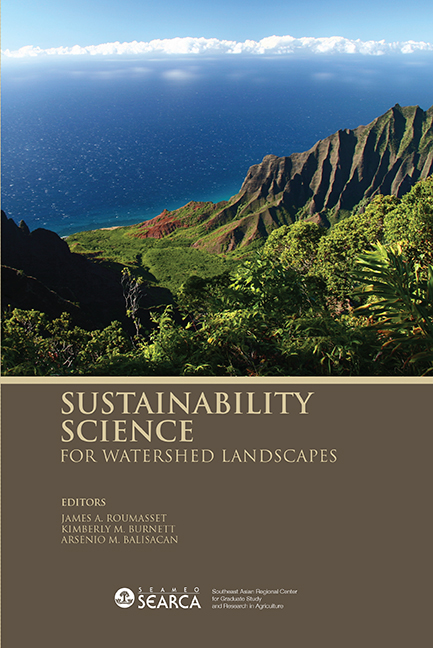Book contents
- Frontmatter
- Contents
- Tables
- Figures
- Message
- Foreword
- Preface
- Acknowledgments
- List of Contributors
- Theme 1 Sustainability Science for Resource Management and Policy
- Theme 2 Monitoring and Modelling
- Theme 3 Participatory Approaches
- 8 Landscape-Scale Conservation: Fostering Partnerships through Ecosystem Service Approaches
- 9 A Participatory Approach to Community Resource Management: Building Upon Local Knowledge and Concerns
- Theme 4 Case Studies
- Synthesis
9 - A Participatory Approach to Community Resource Management: Building Upon Local Knowledge and Concerns
from Theme 3 - Participatory Approaches
Published online by Cambridge University Press: 21 October 2015
- Frontmatter
- Contents
- Tables
- Figures
- Message
- Foreword
- Preface
- Acknowledgments
- List of Contributors
- Theme 1 Sustainability Science for Resource Management and Policy
- Theme 2 Monitoring and Modelling
- Theme 3 Participatory Approaches
- 8 Landscape-Scale Conservation: Fostering Partnerships through Ecosystem Service Approaches
- 9 A Participatory Approach to Community Resource Management: Building Upon Local Knowledge and Concerns
- Theme 4 Case Studies
- Synthesis
Summary
ABSTRACT
Over the last ten years there have been numerous attempts to expand participatory resource management to address issues related to the management of entire watershed. Here the paper describes three case studies including 1) partnerships that have development among landowners in Hawaiʿi to manage watershed resources, 2) a programme to manage an agricultural development project at a watershed level in Timor-Leste, and 3) a successful effort to manage watersheds by conserving upland forests on the island of Pohnpei. Several lessons may be drawn from these and other cases in the literature. First, there is a need to monitor the impact of climate and physical conditions and to also understand how the landscape is both managed and impacted by living populations. Second, managing a watershed involves interaction in time and over space. Third, there is a need to find ways to involve multiple actors with often disparate objectives, and four, there is a need to empirically determine if participatory approaches will work where centrally drive topdown approaches have failed. Lessons gleaned from this assessment related directly to key policy issues including: 1) devolution of authority from central to regional and provincial authorities, 2) processes for improving inter-agency coordination, and 3) the role of local community groups, watershed committees and private sector organizations in the design, implementation and evaluation of integrated watershed management programmes.
INTRODUCTION
Since the mid 1990s, there has been a growth of programmes and projects focused on participatory approaches to community resource management. Over the last 10 years, there have been numerous attempts to mount participatory watershed management programmes throughout the Asia- Pacific region (Upadhayay 2002). Although it is too soon to tell if participatory watershed management (PWM) will succeed as an effective approach in managing large landscapes, two things are clear. First, when looking at resource management within a watershed there is a need to monitor and understand not only the physical conditions and the impact of climate and natural processes, but also how the landscape is both managed and impacted by living populations. Second, there is little in-depth research on the impacts of participatory watershed management (Hinchliffe et. al. 1999)
- Type
- Chapter
- Information
- Sustainability Science for Watershed Landscapes , pp. 219 - 232Publisher: ISEAS–Yusof Ishak InstitutePrint publication year: 2010

